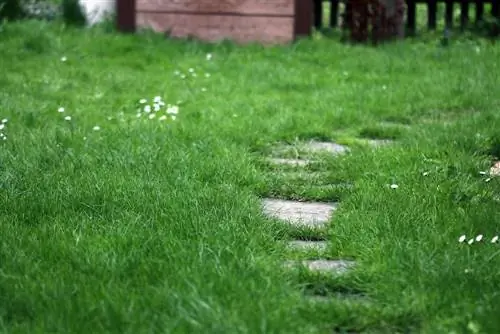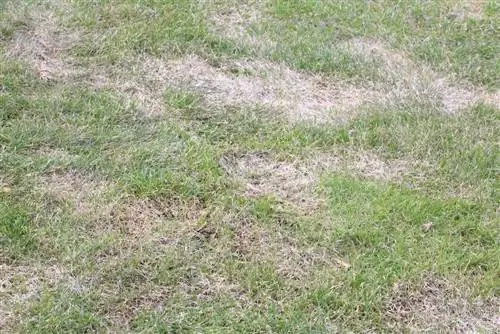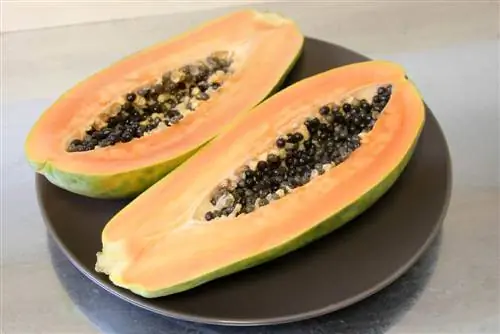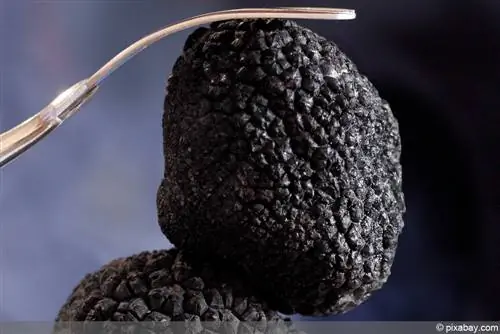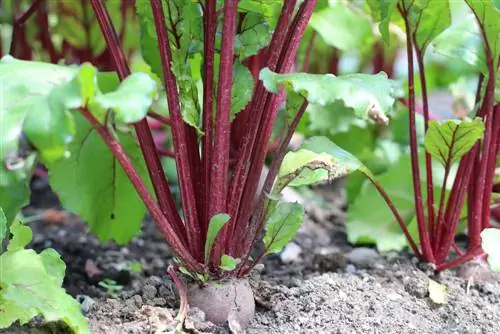- Author admin [email protected].
- Public 2023-12-17 03:39.
- Last modified 2025-01-24 12:45.
A beautiful lawn with a closed cover and a lush green color is what many garden owners want. Care plays a crucial role in this. The question of the speed of growth is justified, because the growth of the lawn determines the mowing cycle. However, how quickly a lawn grows depends on various factors. Growth can be promoted through special measures.
Influencing factors
Every lawn takes a different amount of time to grow. It can take between seven and 20 days for the first stalks to sprout. The journey from seed to blade of grass is a complex process, the duration of which depends on various factors:
- Type of grass: Fescue, meadow panicle, ryegrass, bentgrass
- Lawn type: Ornamental lawn, sports lawn, shade lawn
- Environmental factors: Temperature, light, precipitation
Lawn types and grass types
Ornamental lawns consist of fine-leaved species that show slowed growth. The maintenance required is therefore comparatively low because the leaf mass does not increase as quickly and the lawn needs to be mowed less frequently. Sports and play turf are characterized by their high durability. They consist of particularly fast-growing and robust types of grass that close up even bare spots in a short time. Due to the faster development, this lawn needs to be mowed more frequently. Shade lawns contain various types of grass that can cope with low light. In shady conditions, development is somewhat slower, so this type of lawn requires less attention. Many of the grass species are also included in other mixtures. Shade lawns contain high proportions of grove ripseed or meadow panicle.
- Ornamental lawn: Bent grasses, fescues
- Sports turf: Rye grasses, meadow panicle
- Shadow lawn: Fescue, ryegrass, bluegrass
Germination time
The types of grass take different amounts of time to germinate. The germination time must therefore be taken into account for freshly laid lawns in order to obtain information about the growth rate. Like the growth of grasses, it depends on the environmental conditions. On average, these grasses have the following germination times:
- Redgegrasses: about seven to 15 days
- Fescue: between ten and 20 days
- Bentgrasses: twelve to 20 days
- Panel grasses: approx. 14 to 24 days
Note:
Even if the first grass tips appear after a week, you should allow some time to pass before the first mowing. Once all the grass has reached a height of around eight centimeters, you can mow for the first time.
Environmental factors
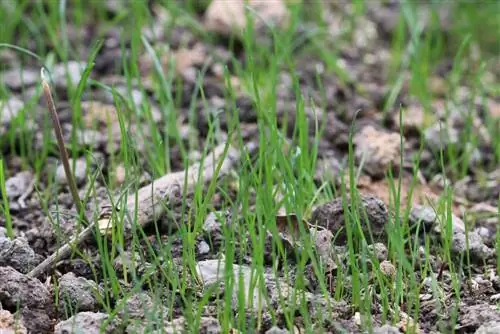
Growth is stimulated by a certain temperature. The crucial factor is the soil temperature at a depth of around five centimeters. For he althy root and shoot growth, the temperature should be between 15 and 18 degrees Celsius. Once the seeds have developed cotyledons, sunlight plays an important role in the subsequent development. Grasses use the sun's energy to produce nutrients. Sun-drenched lawns therefore grow faster than grasses in the shade. However, this only works if the water balance is correct. Excessive sunlight causes the grasses to lose a lot of water through evaporation. In the summer months, the water requirement per square meter is around five liters. If the sky is overcast, the need for fluids is reduced.
Note:
In autumn, the growth rate steadily decreases due to falling temperatures and reduced light. The stalks stop growing at around five degrees Celsius air temperature, while root growth stops at -0.5 degrees Celsius.
Accelerating growth
Loosen the soil thoroughly before sowing. This causes the seeds to fall into protective cracks in the earth where uniform conditions prevail. Cover the seeds only thinly with substrate so that the sprouts can grow more quickly from the surface of the soil. Unwanted species should be removed quickly. Although most types of grass are rather competitive and can hold their own against other plants, so-called weeds rob the grass of nutrients. Provide the seeds with a starter fertilizer. They provide the young grasses with important nutrients for rapid and he althy growth, whereby phosphorus should make up a large proportion of the starter fertilizer.
- Nitrogen: Leaf growth
- Potassium: increases resistance
- Phosphorus: Rooting
Tip:
The young grasses must be able to utilize the nutrients as quickly as possible. Therefore, apply starter fertilizer one to two weeks before sowing.

